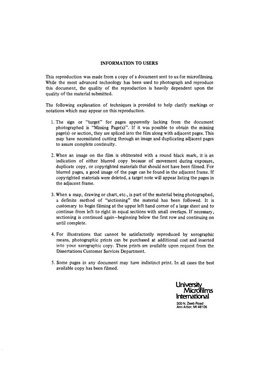| dc.contributor.author | Landon-arnold, Susan Elizabeth, | en_US |
| dc.date.accessioned | 2013-08-16T12:28:46Z | |
| dc.date.available | 2013-08-16T12:28:46Z | |
| dc.date.issued | 1982 | en_US |
| dc.identifier.uri | https://hdl.handle.net/11244/5047 | |
| dc.description.abstract | AFFF proved nontoxic to sewage-type microorganisms within the RBC. However, an organic load of 11.8 kg m('-3) d('-1) resulted in a decrease in dissolved oxygen, thus enriching for "bulking-type" organisms within the first two stages. No correlation between predominant microbial populations and AFFF removal efficiency was apparent for organic loadings below 11.8 kg m('-3) d('-1). | en_US |
| dc.description.abstract | The second phase of the research effort was concerned with the use of a bench-scale aerobic Rotating Biological Contactor (RBC) for treating synthetic wastewater containing AFFF. Enrichment procedures similar to those employed with the chemostat were used. It was determined that the RBC unit was able to treat up to 4,000 mg COD liter('-1) (5.89 kg m('-3) d('-1) organic loading) with a reduction to less than 100 mg COD liter('-1). Treatment of concentrations of 8,000 mg COD liter('-1) (11.79 kg m('-3) d('-1) organic loading) resulted in an effluent containing 200 mg COD liter('-1). | en_US |
| dc.description.abstract | Foam generation by the unit posed a problem by creating additional drag on the discs. This problem was not remedied. A derived mathematical expression, for the unit, expressed effluent concentration as a function of influent organic load. | en_US |
| dc.description.abstract | This was first accomplished by the use of a chemostat. Enrichment for heterogeneous microbial populations capable of utilizing AFFF as their sole carbon source was possible with the chemostat. The data presented show that the concentration of AFFF was reduced from 1,500 mg COD liter('-1) to an acceptable level of 200 mg COD liter('-1). | en_US |
| dc.description.abstract | Aqueous Film Forming Foam (AFFF) is the most effective fire-fighting agent used by the Navy. Disposal and/or treatment of AFFF-containing waste generated by Naval firefighting exercises has become a disposal problem. The object of this research was to determine the feasibility of selecting for microorganisms which would metabolically remove AFFF. | en_US |
| dc.format.extent | vii, 150 leaves : | en_US |
| dc.subject | Biology, Microbiology. | en_US |
| dc.title | Microbial treatability of aqueous film forming foam (AFFF) with a chemostat and a rotating biological contactor. | en_US |
| dc.type | Thesis | en_US |
| dc.thesis.degree | Ph.D. | en_US |
| dc.thesis.degreeDiscipline | Department of Microbiology and Plant Biology | en_US |
| dc.note | Source: Dissertation Abstracts International, Volume: 43-09, Section: B, page: 2808. | en_US |
| ou.identifier | (UMI)AAI8302452 | en_US |
| ou.group | College of Arts and Sciences::Department of Microbiology and Plant Biology | |
